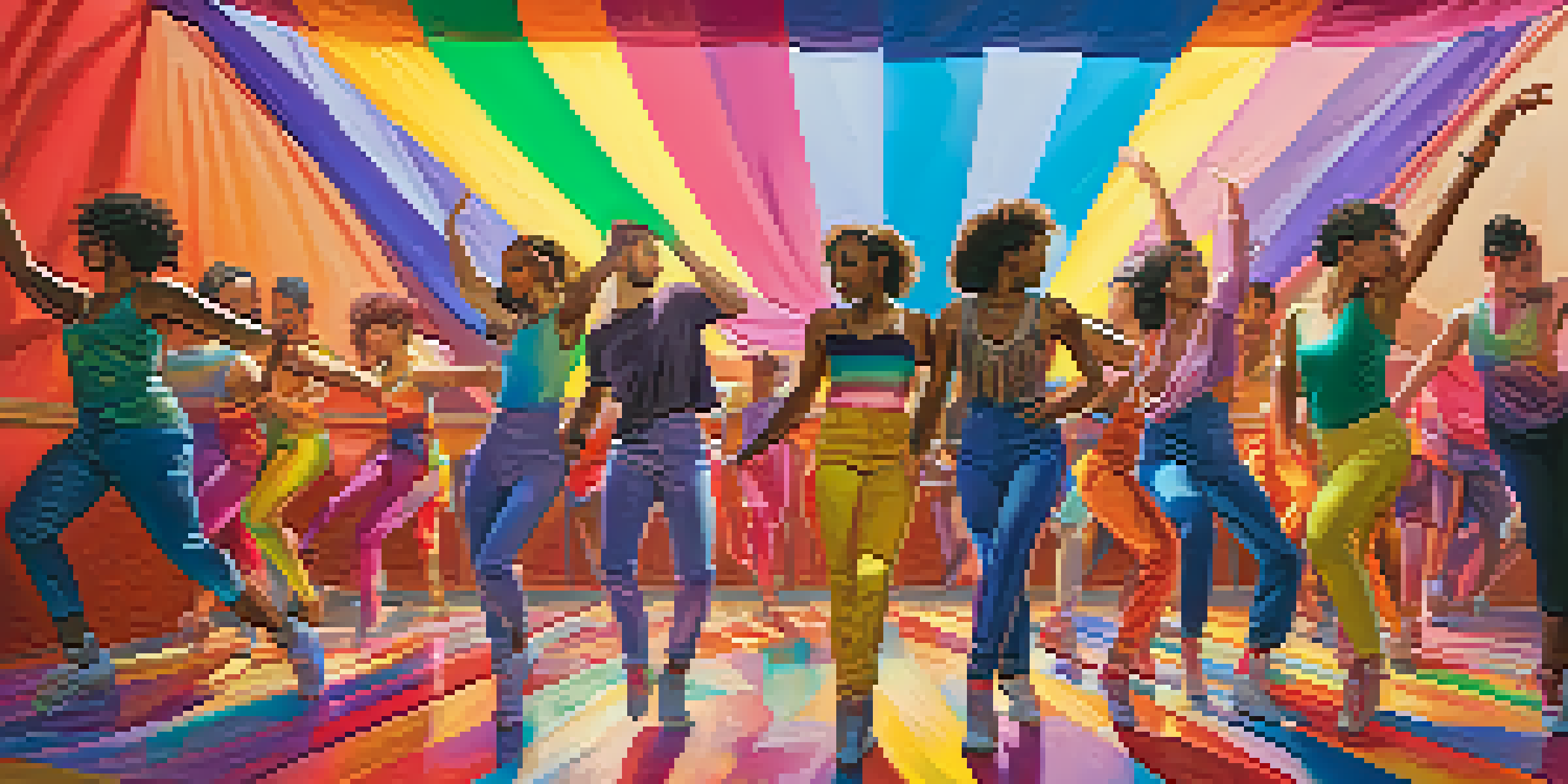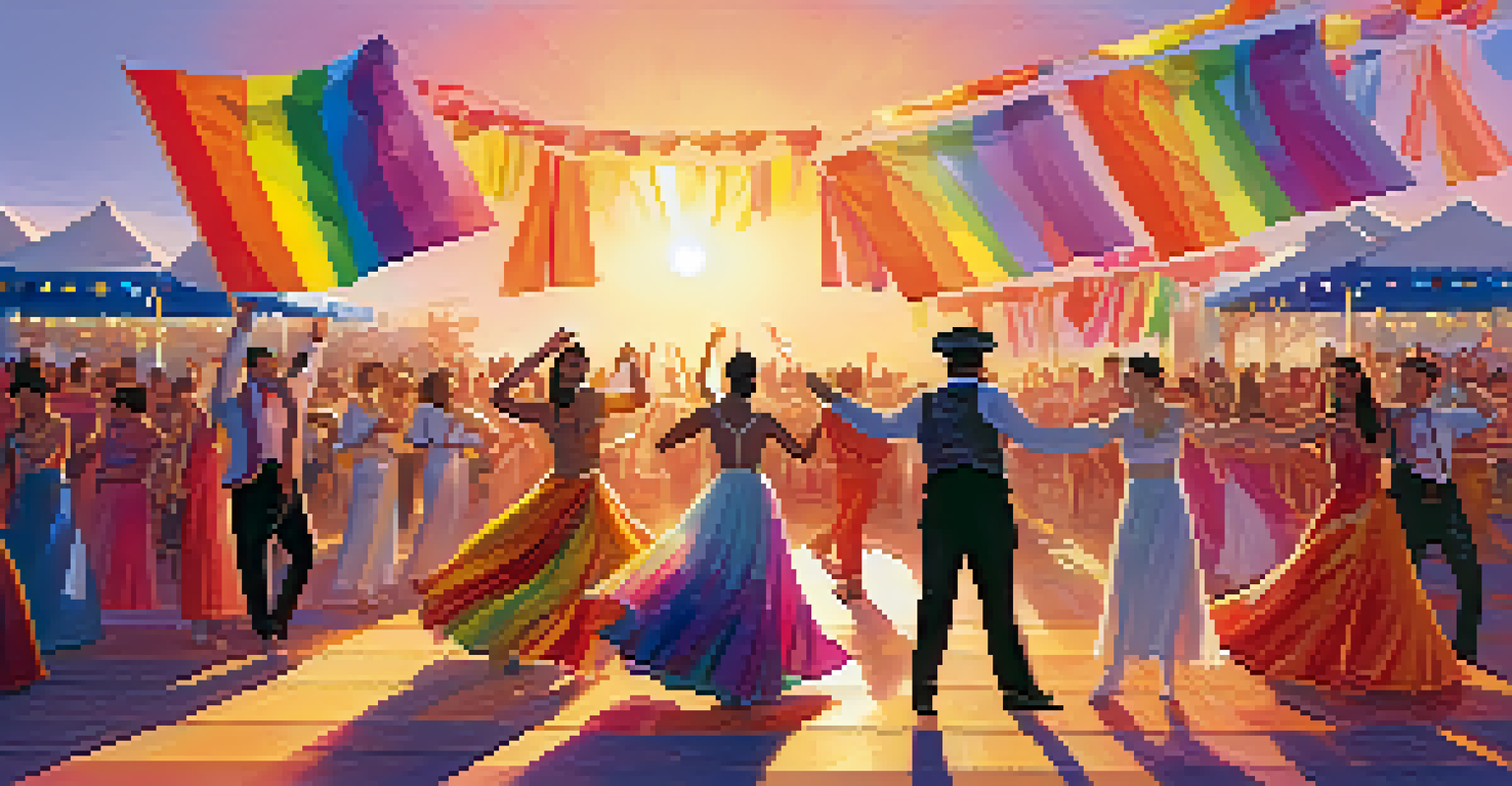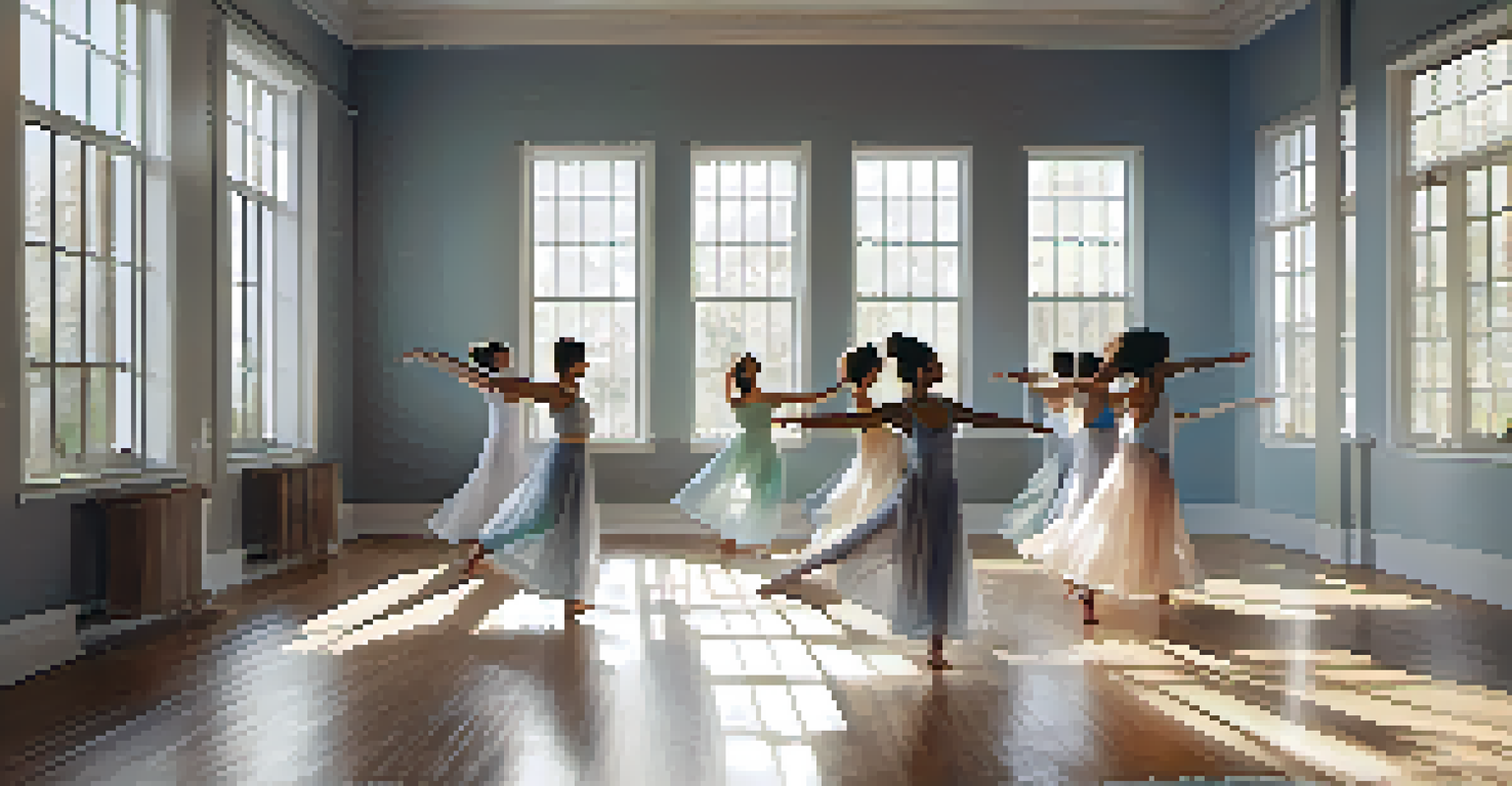Dance and LGBTQ+ Rights: Movement as a Form of Activism

The Historical Connection Between Dance and Activism
Dance has long been intertwined with social movements, serving as a powerful expression of identity and resistance. Historical events, such as the Stonewall Riots, saw dance emerge as a form of protest, with LGBTQ+ individuals using movement to assert their presence and rights. This connection highlights how dance can encapsulate the struggles and joys of marginalized communities, fostering a sense of unity and purpose.
Dance is the hidden language of the soul.
In many cultures, dance is not just an art form; it’s a way to tell stories and share experiences. For the LGBTQ+ community, this storytelling becomes a vital tool for activism, allowing individuals to express their emotions and challenges through movement. The vibrant energy of dance can draw attention to important issues, making it an effective medium for raising awareness.
By linking dance with activism, we can see how movement becomes a form of liberation. It’s a celebration of identity and a rejection of societal norms that often marginalize LGBTQ+ individuals. This blend of art and activism encourages both personal expression and collective action.
Dance as a Safe Space for Self-Expression
For many in the LGBTQ+ community, dance studios and clubs serve as sanctuaries where they can freely express their identities without fear of judgment. These spaces foster a sense of belonging and acceptance, allowing individuals to explore their personal narratives through movement. The freedom to dance authentically can have empowering effects on self-esteem and community connection.

In these environments, participants often find solidarity with others who share similar experiences and struggles. This shared journey transforms the act of dancing into a collective experience, strengthening bonds and encouraging advocacy for LGBTQ+ rights. The dance floor becomes a stage for both personal and political expression, where joy and activism intertwine.
Dance as a Tool for Activism
Dance serves as a powerful medium for the LGBTQ+ community to express identity, raise awareness, and advocate for rights.
Moreover, the act of dancing can be a form of healing for many, providing an outlet for emotions that may be difficult to articulate. By channeling their feelings through movement, individuals can reclaim their narratives and push back against the stigma they face. This healing aspect of dance underscores its role as a vital tool in the fight for equality.
Iconic LGBTQ+ Dancers and Their Impact
Throughout history, several dancers have become icons in the LGBTQ+ community, using their talents to advocate for rights and visibility. Figures like Alvin Ailey and Judith Jamison transformed dance into a platform for social change, demonstrating how art can challenge stereotypes and promote acceptance. Their work has inspired countless individuals to embrace their identities and fight for equality.
The dance is a poem of which each movement is a word.
These dancers not only showcase their artistic prowess but also serve as role models, illustrating the importance of representation in the arts. By standing proud in their identities, they encourage others to do the same, creating a ripple effect within the community. Their influence extends beyond the stage, impacting societal perceptions and advancing LGBTQ+ rights.
Moreover, the legacies of these dancers remind us that the fight for equality is ongoing. Their contributions continue to inspire new generations to use dance as a form of activism, highlighting the vital role the arts play in social movements. By celebrating these icons, we honor their struggles and the progress they’ve helped achieve.
Dance Festivals: Celebrating Identity and Activism
Dance festivals around the world often serve as vibrant celebrations of LGBTQ+ culture and activism. Events like the Sydney Gay and Lesbian Mardi Gras showcase performances that not only entertain but also educate audiences about LGBTQ+ issues. These festivals create a platform for artists to express their identities while fostering a sense of community and pride.
At these gatherings, dance becomes a collective expression of resistance against discrimination and inequality. Participants engage in performances that address social justice themes, intertwining art and activism in a powerful way. This celebration of identity encourages attendees to reflect on their own experiences and engage in dialogue about LGBTQ+ rights.
Safe Spaces for Self-Expression
Dance studios and clubs provide a sanctuary for LGBTQ+ individuals to explore their identities and foster community connection.
In addition, dance festivals often attract diverse audiences, creating opportunities for advocacy and awareness. By showcasing diverse dance forms, these events help to break down stereotypes and promote understanding among different communities. The celebratory atmosphere encourages everyone to join the conversation about equality and acceptance.
The Role of Social Media in Dance Activism
In today’s digital age, social media has become a powerful tool for dance activism within the LGBTQ+ community. Platforms like Instagram and TikTok allow dancers to share their movements and messages with a global audience, amplifying their voices and stories. This accessibility enables artists to connect with others and mobilize support for LGBTQ+ rights through creative expression.
Social media challenges traditional boundaries, allowing marginalized voices to be heard in ways that were once unimaginable. Dancers can create viral content that raises awareness about pressing issues, fostering community engagement and solidarity. This digital activism often blurs the line between art and advocacy, encouraging audiences to reflect on the messages conveyed through dance.
Moreover, the interactive nature of social media encourages participation and dialogue. Audiences are not merely passive consumers; they can engage with content, share their own stories, and join movements. This democratization of dance activism empowers individuals to take a stand for LGBTQ+ rights, creating a global community united through movement.
Dance Therapy: Healing Through Movement
Dance therapy has emerged as a crucial aspect of healing for many in the LGBTQ+ community, providing a therapeutic outlet for emotional expression. This form of therapy encourages individuals to explore their feelings and experiences through movement, promoting mental well-being and self-discovery. It offers a safe space for those grappling with identity and societal pressures.
By engaging in dance therapy, individuals can confront and process their emotions, leading to personal growth and empowerment. The act of moving can help release pent-up feelings, allowing participants to find solace and clarity. This therapeutic approach emphasizes the connection between body and mind, highlighting the importance of movement in healing.
Social Media Amplifies Voices
Platforms like Instagram and TikTok allow dancers to share their stories and mobilize support for LGBTQ+ rights on a global scale.
Furthermore, dance therapy fosters a sense of community among participants, as they share their journeys and support one another. This camaraderie enhances the healing process, reminding individuals that they are not alone in their struggles. As a result, dance therapy becomes not just a healing practice but also a form of activism that champions mental health awareness within the LGBTQ+ community.
The Future of Dance and LGBTQ+ Activism
As we look to the future, the intersection of dance and LGBTQ+ activism continues to evolve, reflecting changing societal attitudes and challenges. New generations of dancers are exploring innovative ways to combine their art with advocacy, pushing boundaries and redefining what activism looks like. This evolution ensures that the spirit of resistance remains alive and vibrant within the community.
Emerging trends, such as virtual performances and collaborations, offer fresh avenues for expression and activism. Dancers are harnessing technology to reach wider audiences, using their platforms to inspire change and promote LGBTQ+ rights. This adaptability highlights the resilience of the community and the enduring power of dance as a means of advocacy.

Ultimately, the future of dance and LGBTQ+ rights is bright, fueled by creativity, passion, and a commitment to social justice. As artists continue to use their voices and movements to challenge norms, they pave the way for greater acceptance and equality. By embracing this dynamic relationship, we can look forward to a world where dance remains a powerful tool for activism and celebration.